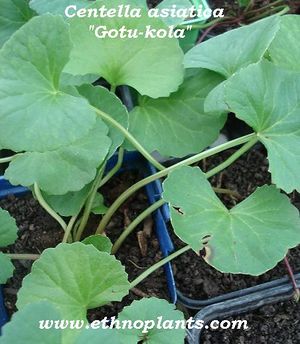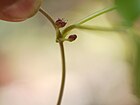Note: This is a project under development. The articles on this wiki are just being initiated and broadly incomplete. You can Help creating new pages.
Difference between revisions of "Centella asiatica - Mandooka Parni"
(→Uses) |
(→How to plant/cultivate) |
||
| Line 55: | Line 55: | ||
==How to plant/cultivate== | ==How to plant/cultivate== | ||
| − | + | Centella asiatica, more commonly known as gotu kola, has enjoyed a long history as a medicinal herb in the Orient<ref name="How to plant/cultivate"/> | |
==Commonly seen growing in areas== | ==Commonly seen growing in areas== | ||
Revision as of 10:24, 28 April 2018
Centella asiatica is a small, herbaceous, frost-tender perennial plant of the family Mackinlayaceae. it is a small creeping herb with shovel shaped leaves emerging alternately in clusters at the stem nodes.
Contents
- 1 Uses
- 2 Parts Used
- 3 Chemical Composition
- 4 Common names
- 5 Properties
- 6 Habit
- 7 Identification
- 8 List of Ayurvedic medicine in which the herb is used
- 9 Where to get the saplings
- 10 Mode of Propagation
- 11 How to plant/cultivate
- 12 Commonly seen growing in areas
- 13 Photo Gallery
- 14 References
- 15 External Links
Uses
Hysteria, Dysuria, Insomnia, swelling, chronic ulcers, cold, cough, Diarrhea, asthma.
Parts Used
Chemical Composition
Centella asiatica has large amounts of pentacyclic triterpenoids including asiaticoside, brahmoside, asiatic acid, and brahmic acid[1]
Common names
| Language | Common name |
|---|---|
| Kannada | brahmi soppu |
| Hindi | ballari, bheki |
| Malayalam | kutakam |
| Tamil | kacappi |
| Telugu | mandukaparni |
| Marathi | NA |
| Gujarathi | NA |
| Punjabi | NA |
| Kashmiri | NA |
| Sanskrit | bhandi |
| English | Pennywort, coinwort |
Properties
Reference: Dravya - Substance, Rasa - Taste, Guna - Qualities, Veerya - Potency, Vipaka - Post-digesion effect, Karma - Pharmacological activity, Prabhava - Therepeutics.
Dravya
Rasa
Guna
Veerya
Vipaka
Karma
Prabhava
Habit
Identification
Leaf
| Kind | Shape | Feature |
|---|---|---|
| Simple | The leaves are divided into 3-6 toothed leaflets, with smaller leaflets in between |
Flower
| Type | Size | Color and composition | Stamen | More information |
|---|---|---|---|---|
| Unisexual | 2-4cm long | Yellow | 5-20 | Flowers Season is June - August |
Fruit
| Type | Size | Mass | Appearance | Seeds | More information |
|---|---|---|---|---|---|
| 7–10 mm (0.28–0.4 in.) long pome | clearly grooved lengthwise, Lowest hooked hairs aligned towards crown | With hooked hairs | {{{6}}} |
Other features
List of Ayurvedic medicine in which the herb is used
- Vishatinduka Taila as root juice extract
Where to get the saplings
Mode of Propagation
How to plant/cultivate
Centella asiatica, more commonly known as gotu kola, has enjoyed a long history as a medicinal herb in the Orient[3]
Commonly seen growing in areas
Photo Gallery
References
External Links
- Ayurvedic Herbs known to be helpful to treat Hysteria
- Ayurvedic Herbs known to be helpful to treat Dysuria
- Ayurvedic Herbs known to be helpful to treat Insomnia
- Ayurvedic Herbs known to be helpful to treat swelling
- Ayurvedic Herbs known to be helpful to treat chronic ulcers
- Ayurvedic Herbs known to be helpful to treat cold
- Ayurvedic Herbs known to be helpful to treat cough
- Ayurvedic Herbs known to be helpful to treat Diarrhea
- Ayurvedic Herbs known to be helpful to treat asthma
- Herbs with Leaves used in medicine
- Herbs with Stem used in medicine
- Herbs with Root used in medicine
- Herbs with common name in Kannada
- Herbs with common name in Hindi
- Herbs with common name in Malayalam
- Herbs with common name in Tamil
- Herbs with common name in Telugu
- Herbs with common name in Sanskrit
- Herbs with common name in English
- Habit - Herb
- Index of Plants which can be propagated by Seeds
- Index of Plants which can be propagated by Cuttings
- Herbs that are commonly seen in the region of Along ditches
- Herbs that are commonly seen in the region of Wet areas
- Herbs








